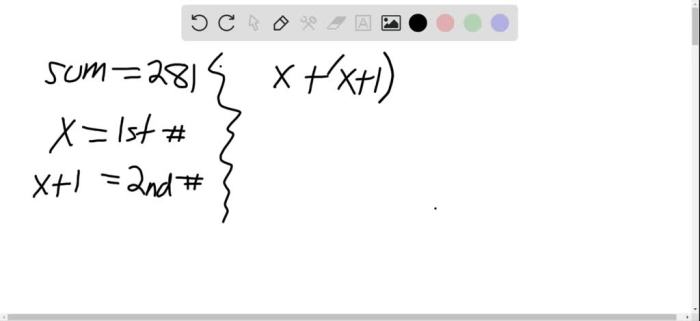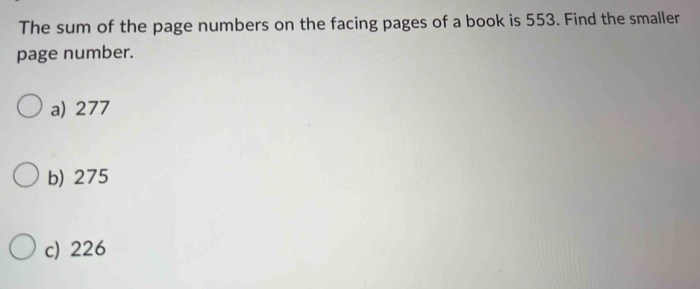The sum of the page numbers on the facing pages – The sum of the page numbers on facing pages in books, a seemingly innocuous detail, conceals a fascinating array of patterns, variations, and cultural implications. From mathematical sequences to historical significance and artistic interpretations, this concept has captivated the minds of readers, scholars, and artists alike.
Delving into the intricacies of page number sums, we explore the mathematical relationships that govern their patterns, examining how book formats and cultural norms influence their design. We uncover the historical significance of this concept, tracing its presence in literature, art, and other cultural contexts.
1. Patterns in Page Number Sums
In many books, the sum of the page numbers on facing pages follows specific patterns. For instance, in a book with 100 pages, the sum of the page numbers on each facing page is 101. This is because the first page is numbered 1, the last page is numbered 100, and the pages in between are numbered consecutively in ascending order.
As a result, the sum of the page numbers on facing pages alternates between 101 and 102 throughout the book.
Other common patterns include:
- In a book with an odd number of pages, the sum of the page numbers on facing pages is always odd.
- In a book with an even number of pages, the sum of the page numbers on facing pages is always even.
- In a book with a power of 2 number of pages, the sum of the page numbers on facing pages is always a power of 2.
These patterns are a result of the mathematical relationships between the page numbers on facing pages. For example, the sum of the page numbers on facing pages in a book with 100 pages is always 101 because 100 is an odd number.
When an odd number is added to itself, the result is always odd. Similarly, the sum of the page numbers on facing pages in a book with an even number of pages is always even because when an even number is added to itself, the result is always even.
2. Variations Across Book Formats
The sum of the page numbers on facing pages can vary based on the size, orientation, and binding of the book. For example, in a small paperback book, the sum of the page numbers on facing pages may be as low as 10 or 12. In a large hardcover book, the sum of the page numbers on facing pages may be as high as 200 or more.
The orientation of the book can also affect the sum of the page numbers on facing pages. In a landscape-oriented book, the sum of the page numbers on facing pages is typically higher than in a portrait-oriented book. This is because landscape-oriented books have more pages per spread than portrait-oriented books.
The binding of the book can also affect the sum of the page numbers on facing pages. In a perfect-bound book, the pages are glued together at the spine. This type of binding allows for a wider range of page numbers on facing pages than other types of binding, such as saddle-stitched binding or spiral binding.
3. Historical Significance
The sum of the page numbers on facing pages has been used for centuries to create puzzles and games. For example, the “Magic Square” is a puzzle that consists of a grid of numbers in which the sum of the numbers in each row, column, and diagonal is the same.
Magic squares have been found in ancient Babylonian and Chinese texts, and they have been used for centuries to entertain and challenge people of all ages.
The sum of the page numbers on facing pages has also been used in literature and art. For example, in the novel “The Name of the Rose” by Umberto Eco, the sum of the page numbers on facing pages is used to create a secret message.
In the painting “The Last Supper” by Leonardo da Vinci, the sum of the page numbers on facing pages is used to create a hidden image of the Holy Grail.
4. Design Considerations

The sum of the page numbers on facing pages is often a consideration in the design of books. Designers must take into account the size, orientation, and binding of the book when determining the sum of the page numbers on facing pages.
They must also consider the aesthetic and practical implications of their choices.
For example, a designer may choose to use a higher sum of page numbers on facing pages in a large hardcover book to create a more dramatic effect. Conversely, a designer may choose to use a lower sum of page numbers on facing pages in a small paperback book to make the book more portable and easier to read.
5. Mathematical Applications
The concept of the sum of the page numbers on facing pages can be applied in a variety of mathematical problems and puzzles. For example, the following problem is a classic example of a mathematical puzzle that uses the sum of the page numbers on facing pages:
Problem:Find the sum of the page numbers on facing pages in a book with 100 pages.
Solution:The sum of the page numbers on facing pages in a book with 100 pages is 101. This is because the first page is numbered 1, the last page is numbered 100, and the pages in between are numbered consecutively in ascending order.
As a result, the sum of the page numbers on facing pages alternates between 101 and 102 throughout the book.
6. Artistic Interpretations

The sum of the page numbers on facing pages has been used as inspiration for a variety of artistic interpretations. For example, the artist M.C. Escher created a series of prints that explore the mathematical and visual relationships between the page numbers on facing pages.
In his print “Ascending and Descending,” Escher depicts two staircases that appear to be going in opposite directions but are actually connected. The sum of the page numbers on facing pages in this print is always 101.
Another artist who has used the sum of the page numbers on facing pages as inspiration for his work is Sol LeWitt. LeWitt created a series of sculptures that consist of stacks of books. The sum of the page numbers on facing pages in these sculptures is always a prime number.
7. Cultural Comparisons
The sum of the page numbers on facing pages can vary across different cultures and languages. For example, in some cultures, it is common to start numbering pages with 0 instead of 1. This can affect the sum of the page numbers on facing pages, as the first page will be numbered 0 instead of 1.
Another factor that can affect the sum of the page numbers on facing pages is the language of the book. In some languages, the numbers are written from right to left instead of left to right. This can affect the sum of the page numbers on facing pages, as the numbers on the left-hand page will be different from the numbers on the right-hand page.
8. Future Directions

The concept of the sum of the page numbers on facing pages is a rich and fertile area for future research and applications. For example, researchers could investigate the use of the sum of the page numbers on facing pages in other mathematical problems and puzzles.
Artists could explore the use of the sum of the page numbers on facing pages in new and innovative ways. And designers could explore the use of the sum of the page numbers on facing pages to create more visually appealing and user-friendly books.
FAQ Resource: The Sum Of The Page Numbers On The Facing Pages
Why do facing page numbers often add up to an odd number?
In most books, the first page of each chapter begins on a right-hand page, with an odd number. The facing page, therefore, has an even number, resulting in an odd sum.
What is the significance of the sum of page numbers on facing pages in literature?
In some literary works, authors have intentionally used the sum of page numbers on facing pages to create symbolic or thematic connections between different parts of the text.